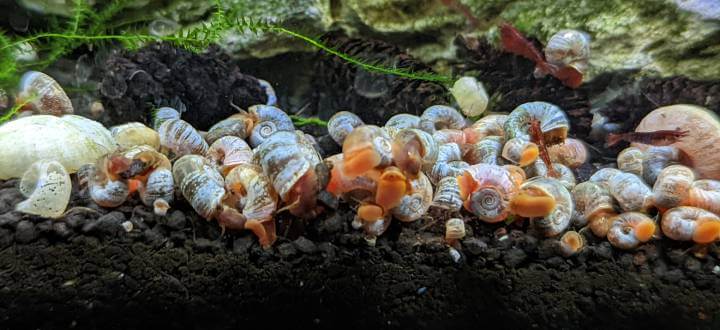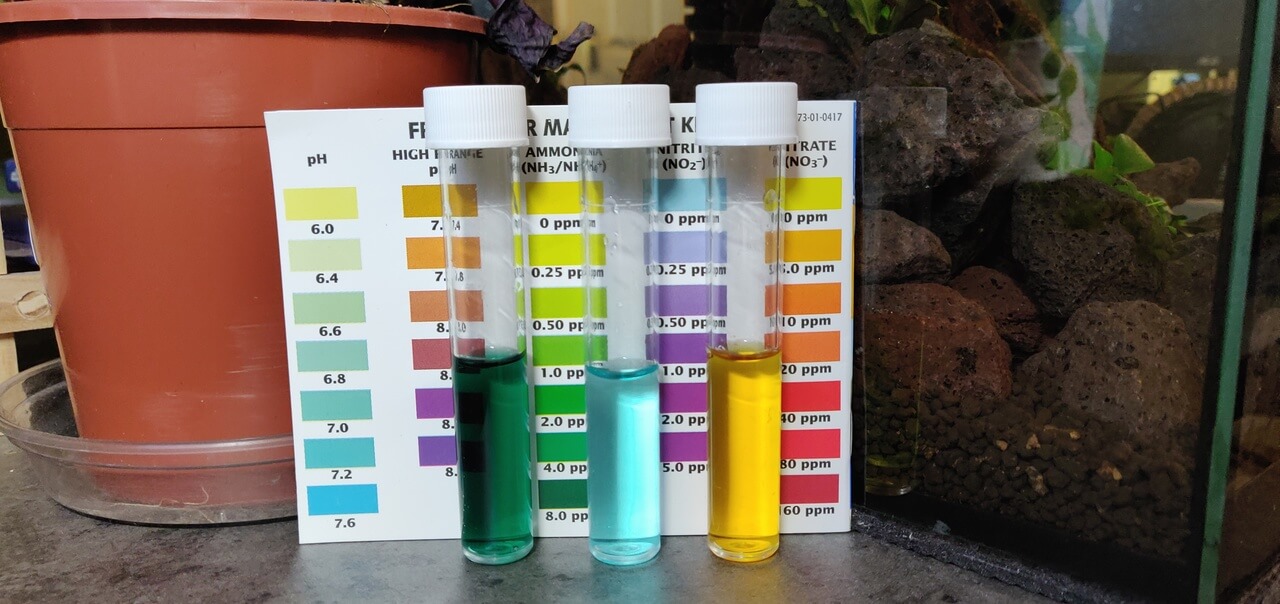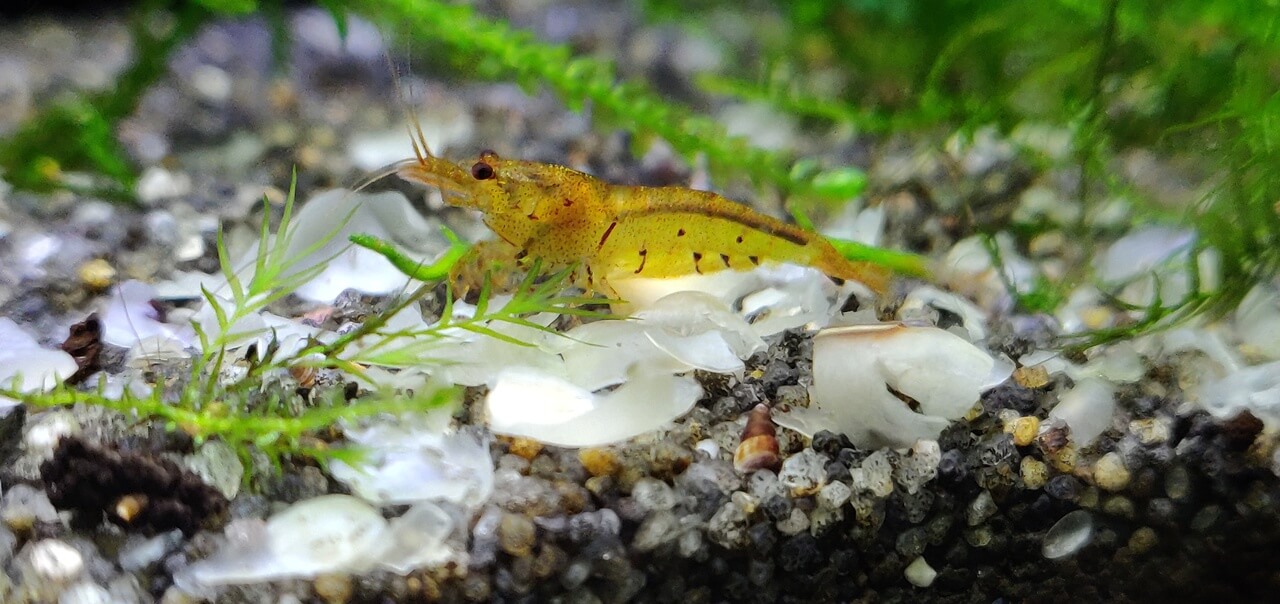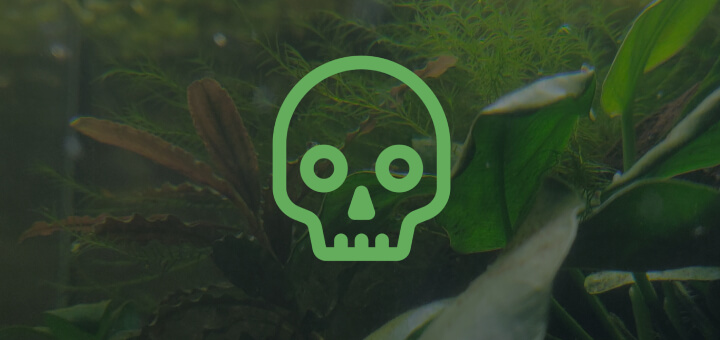There are many reasons why shrimp die and it’s not always a simple task to identify any single cause.
This article will walk through the options to help you identify any changes you need to make.
First steps
The most important first step here is to remain calm and avoid making any sudden changes.
Are your shrimp dying one by one over night for days in a row or have you only noticed a single death?
Making hasty changes to the tank is likely to cause the shrimp more stress, and could lead to further deaths.
Should you remove dead shrimp?
This can be quite a divisive question for many shrimp keepers. As a rule of thumb, if the death was natural, like old age, it’s probably safe and healthy to leave the dead shrimp in the tank.
Shrimp are detritivores, meaning they’ll eat both plants and dead organic material, so will happily eat other late shrimp. Eating their own is strangely a great way to ensure they get all of the nutrients they need.
However, if you can’t pinpoint a likely cause of death and it’s probably for the best to remove the body. In some cases there could be a disease working through the aquarium and it’d be wise to limit the spread if you’re unsure.
Another reason to remove a dead shrimp is if your tank is small, or you don’t have many shrimp or snails. Allowing the body to decay before it can be eaten will lead to ammonia polluting the water and cause more issues.

Why do they turn pink?
When a shrimp dies, regardless of the colour it used to be, it will turn to a shade of pink/orange.
This is caused by a type of pigment in their body called Carotenoids. These aren’t produced by the shrimp themselves but taken in from algae and other plant matter that created them.
The carotenoids create bonds with other proteins in the body. When these bonds start to break down, such as in death, the astaxanthin carotenoids (red pigment) replaces whatever pigment was previously present in the body.
This change of pigments is what causes the body to turn a pinky-orange colour.
Water changes
Learning how to safely perform a water change in your shrimp tank can help to prevent a few of these issues.
Changing water too quickly
Shrimp are very sensitive to changes in water quality, and a quick shift in TDS or temperature for example can put them into shock.
Symptoms of this include:
- Shrimp swimming constantly around the tank in circles (not to be confused with male mating behaviour)
- Flinching or “jumpy” shrimp
The best solution to this is to ensure you drip acclimate the new water into the tank, as if they were new shrimp again. This allows the shrimp to adjust to any minor changes in the water without stressing them.
Changing too much water
Similar to changing the water too quickly, it’s important not to replace too much in a water change.
What may seem like a minor difference in TDS, GH, KH, or temperature to us can cause a lot of stress to a shrimp’s body. Increasing or decreasing the mineral content of the water can cause failed molts and sometimes lead to death.
Try to limit water changes to roughly 10% a week, or 20% every two weeks.
Water quality problems
Freshwater dwarf shrimp are much more sensitive to water quality than most fish and snails and is probably the most likely cause of deaths for beginner shrimp keepers.
It’s vital to try and keep the water parameters within the acceptable range for the species you’re keeping.
To keep your colony healthy, you should be monitoring at least these parameters:
Uncycled tank
An uncycled tank is simply an aquarium that either hasn’t finished its nitrogen cycle, or has crashed and needs to restart this process.

This means that there isn’t enough beneficial bacteria in the tank to break down the waste from the tanks inhabitants. The ammonia they produce is also toxic to them, so the bacteria plays a key role in keeping the water safe.
Symptoms:
- An Ammonia level higher than 0ppm
- A nitrite level higher than 0ppm
- Adding shrimp to a recently setup tank (less than 2 months old)
To deal with any ammonia in the water you should try and get hold of a detoxifier like Seachem Prime. You can mix this into the water to immediately detoxify the dangerous ammonia and nitrite until the beneficial bacteria has had time to grow properly.
Overfeeding
Putting too much food into a tank could cause an ammonia spike as the food begins to decay and break down.
The symptoms for this issue will be almost identical to that of an uncycled tank. If any ammonia or nitrite can be measured in the water and the food stays in the tank for hours-days, this is likely the cause.
Ideally you should only add enough food for the shrimp colony to eat completely within a couple of hours. Anything left uneaten after that time should be removed until your colony has stabilised again.
Chlorine water
If you use tap water, rather than mixing salts with RODI water for example, you need to be very careful with chlorine/chloramine.
Most countries use chlorine/chloramine in their water systems to keep the water safe from infection for human consumption. However, a safe level for humans is way past the safe limit for shrimp.
Symptoms:
- Hyperactive shrimp soon after a water change
- Lethargic shrimp a little white later, barely moving around
Make sure you’re using a trustworthy water conditioner like Seachem Prime in the correct dose to rule this out.
Copper poisoning
Copper is a very powerful pesticide against invertebrates like shrimp and snails, even a miniscule amount can be deadly.
A common way it gets introduced to a tank is on unsafe plants that haven’t been rinsed/quarantined properly. If you’re wanting to add plants to your aquarium, try to make sure they’re shrimp safe (free of pesticides).
Some plumbing systems at home could have corroded water pipes and cause a higher amount of copper in the aquarium water.
Similar to with chlorine water, you’ll notice the shrimp barely moving as the copper weakens their bodies.
If you’re unsure if copper could be the issue, you can buy copper testing kits to get your answer. In the event you do find an unsafe level of copper, you should perform a fairly large water change ASAP. Remember to drip acclimate to avoid stressing them out any further.
Unsafe chemicals
You should be very careful with everything that enters the shrimp tank, even by mistake. Even something as simple as putting your hand into the tank could devastate a colony if you have leftover soap from washing your hands recently for example.
Some plant fertilizers can contain chemicals toxic to shrimp/invertebrates so be sure to read the ingredients and look online before you use anything new like this.
In new aquariums, they may have been cleaned with strong glass cleaners, vinegar, or bleach, so it’s strongly recommended to rinse a new tank and wipe it with tap water.
Air freshener is another unexpected danger for our aquariums. When sprayed nearby the particles can fall into the tank water and behave as if you’d added disinfectant directly.
Symptoms:
- Lethargic behaviour
- Jumpy shrimp, swimming erratically
If you suspect there are unsafe chemicals in your tank, you should perform a large water as soon as you can.
Underfeeding
Just like with overfeeding, feeding too little can lead to poor health and death in some cases.
Symptoms:
- Shrimp rushing to any source of food
- Lack of baby shrimp, or low survival rate
One of the most common causes for a low baby survival rate is lack of biofilm or algae. Baby shrimp don’t really move much in the first few weeks so they rely on a mature tank with plenty of biofilm to graze on.
Introducing powder food made specifically for baby shrimp, like Bacter AE should sort this out. Alternatively, floating pellets of bee pollen and allowing the dust to spread around the tank is another great option.
To avoid worrying about polluting the water with decaying food, try using snowflake food for peace of mind.

New shrimp
Poor travel
You may have setup the perfect new tank that’s completely cycled and coated in layers of biofilm ready for the new inhabitants. Somehow though, some of the new shrimp you ordered didn’t seem to last more than a few hours.
Sometimes these deaths are almost unavoidable. Being sent through couriers across the country in a dark box is a very stressful experience for them.
Respectable sellers will typically only ship out younger shrimp (up to a few months old) as they’re generally hardier and able to tolerate this experience better than fully grown adults. If given the choice, always try to choose the younger shrimp when buying new shrimp for this reason.
Previous conditions
Similarly, it’s not always easy to tell what the seller’s water quality is like online.
Sometimes they may have been living in suboptimal conditions and the shipping process is just too much for them.
If you have a bad experience, try testing the water they arrived in see if it’s within an acceptable range for the species. Finding a new seller is the best solution to this.
Rushed acclimation
It can be an exciting time getting some brand new tank mates but you need to make sure you’re acclimating them safely.
Just like with changing water too quickly, which is essentially what you’ll be doing as they move to your new water, you should slowly drip acclimate over a few hours.
Never use the “plop and drop” method for shrimp, some may claim success but it’s an unnecessary risk and causes them stress.
Pests
If your water is safe and everything else seems to be in order, it’s time to check for unwelcome pests in your system.
Hydra
Hydra are tiny freshwater polyps that will grow on almost anything including the glass walls, filter sponges, plants, rocks, wood, etc.
They look like a tiny tree and are usually cloudy-white or green in colour.
Planaria
Planaria are small worms with diamond-shaped heads that hide in your substrate and eat any leftovers. It’s possible for planaria to hurt your shrimp as they can try to get under their shells.
They’re a clear sign that you’re overfeeding, so if you notice them you should cut back on feeding immediately and try to get rid of them.
Diseases / Parasites
Vorticella
Vorticella is a type of parasite that causes your shrimp to grow white fuzz near their mouth, similar to a fungus.
If you notice a possible Vorticella infection you should quarantine that shrimp immediately to protect the rest of your colony.
Scutariella Japonica
Not to be confused with Vorticella, this parasite can appear similar. Scutariella Japonica are parasitic nematodes that look like small (1-2 mm) spikes typically near the eyes.
The first step in dealing with a possible infection of this is again to quarantine the ill as soon as possible to prevent spreading.
Muscular Necrosis
Muscular Necrosis is an infection of the muscle tissue that causes a shrimp to turn a milky white colour. This is usually most often visible near the tail.
The milky colour is caused by protein in the muscle breaking down as the cell decays.

